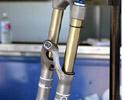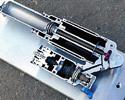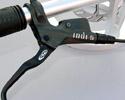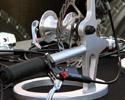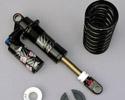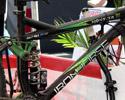
Recently on Cyclingnews.com |
Sea Otter Classic Tech, April 21, 2007
Fox Racing Shox delivers even more performance, SRAM continues winning ways
By James Huang in Monterey, CA
Fox Racing Shox focuses on internal improvements for 2008
Fox Racing Shox is a company steeped in racing and it isn't afraid to admit it. Although the company holds championship titles in every discipline in which it participates, it still apparently is in no hurry to call it a day. According to Bicycle Division Vice President Mario Galasso, "We're a competitive company; we like to win."
As such, the chassis for two of its most popular platforms have been completely re-engineered and nearly the entire line (save for the 40) receives new lower leg castings. The most significant changes, though, aren't even visible from the outside. All of the 2008 forks receive subtle damper refinements that are wholly intended to help riders go faster and with more control.
Low-speed compression damping rates (as in damper shaft speed, not rider speed) have been increased to resist brake dive and also to make for a more seamless progression into the medium and high-speed compression ranges. Since the compression damper now assumes a greater portion of the burden in absorbing trail irregularities, inflation pressures and spring rates have decreased, thus enhancing overall plushness, but the forks will still sit up a little bit higher in their stroke. Lastly, a modification in the rebound damper check valve minimizes the 'confusion' that forks typically experience when transitioning from the compression to the rebound stroke.
Did we lose you back there somewhere around 'low-speed'? No matter. Fox Racing Shox says the end result of the updates is an overall increase in traction, reduced high-frequency harshness, and a generally more planted-feeling front end. According to Fox's Christoph Ritzler, the changes feel "like going from a 2.1" cross-country tire and a 2.5" super tacky tire."
After a few short test rides on the trails surrounding the Laguna Seca racetrack where we compared '07 and '08 products back-to-back, we have no choice but to emphatically agree with the company's claims. Small-bump compliance seemed pleasantly unaffected by the changes, but the calmer front end lent noticeably more confidence in rough corners and on washboard. We were already quite happy with the existing product, but the ride quality and performance improvements of the new damper tune are real and significant. Thankfully, '07 and earlier forks aren't obsolete; all of the changes can be retrofitted into existing product, although it sounds like it may be an exclusively mail-in affair.
As for the chassis changes (you didn't think we'd forget, did you?), the lightweight F Series drops over 100g (depending on model) off of last year's version courtesy of a new crown and new quad-tapered lower leg casting. A new dedicated 120mm version will now join the convertible 80/100mm models, and all will be available in R, RL, and RLC flavors in either gloss white or black finishes.
Each model in the 36 platform also drops nearly as much weight as on the F Series, supposedly without sacrificing anything other than a few innocent grams. A new forged aluminum crown is said to be both lighter and stiffer, and the new magnesium lower leg casting now features a tool-free quick-release 20mm thru-axle system (which bears striking resemblance to Rock Shox's old Tullio setup). The aluminum axle itself is now hollow-forged, yielding a claimed 10% decrease in weight, but also 35% and 60% increases in shear strength and torsional strength, respectively.
The entire fork line (again, save for the 40) now utilizes post mount disc brake tabs, and a revision to the brilliantly handy brake hose guide greatly simplifies installation. A taller lockout lever on RL and RLC models now also shrouds the rebound knob, meaning riders are less apt to alter their rebound adjustments when locking out the fork. Sadly, the Terralogic-equipped X Series will not see the light of day past the '07 model year, but some of the new models will accept a damper transplant depending on travel and parts availability.
Changes to Fox's rear shocks are mostly evolutionary and include a new easier-to access angled Schrader valve on Float models and a simplified two-position ProPedal lever on the DHX Air 5.0 and 4.0 which replaces the old 15-position dial. The DHX Air and DHX Coil models also get a wider adjustment range for both low-speed compression damping and bottom-out control.
Otherwise, all of the rear shocks receive the same damper refinements as on the fork lineup. In contrast with the forks, though, those differences were too subtle for us to notice on our brief test rides, meaning that the new rear shocks aren't much of an improvement… or that the old ones were already quite good. Based on our experiences, we're inclined to go with the latter.
SRAM refocuses on rear shocks, refines core products
SRAM successfully pulled the iconic Rock Shox brand out of the ashes after its acquisition with what has turned out to be a stellar line of suspension forks. Now the company wants to redirect its attention back towards the rear end with a long-overdue DH/FR coil-over model as well as a new XC/AM air-sprung shock that will eventually replace the MC and Pearl platforms.
Rock Shox focused on durability for the new Vivid coil shock which incorporates a one-piece body that eliminates a critical o-ring, extra-large cross-sections for the remaining seals, a 12.7mm (1/2") diameter hard-anodized aluminum shaft, a long seal head bushing to minimize the effects of side-loading, and hard-anodized three-piece mounting hardware. The piggyback-style rear shock also utilizes rear shock-specific fluid instead of cheaper fork oils that break down more readily.
In terms of external damping adjustments, Rock Shox has chosen to supply the new Vivid with only "the ones that matter", including low-speed compression, beginning stroke rebound, and ending stroke rebound. All of those adjustments are also fully isolated to keep one setting from affecting another. Spring preload is provided by the standard threaded collar setup, but bottom-out tuning is now handled by a clever Drop Stop system that allows users to swap out the conical bottom-out pads just by removing the coil. For now, the Vivid will only be offered with a steel coil.
Rock Shox currently has three sizes planned: 240mm x 76mm (9.5" x 3.0"), 222mm x 77mm (8.75" x 2.75"), and 216mm x 63.5mm (8.75" x 2.5"). Claimed weight is 426g for the 216mm model without coil.
We first spotted Rock Shox's new Monarch rear shock on Sam Schultz's Gary Fisher Supercaliber back at NMBS #1 in Arizona, but SRAM finally unveiled its details at Sea Otter. The air-sprung Monarch is aimed at bikes with 80-160mm of rear wheel travel and is said to offer "seamless bump performance in a lightweight package," according to SRAMbassador Greg Herbold. Features include a relatively small-diameter air can for improved frame clearance, but a large oil volume (more than MC, but less than Pearl) for more consistent damper performance and less fade. A larger diameter air can will also be available for those desiring a more linear spring rate.
Monarch will use Rock Shox's Solo Air air chamber design that automatically balances positive and negative pressures via a single Schrader valve which swivels out for easier access but also tucks tightly against the shock to reduce the risk of damage. Sag gradients will be anodized directly into the damper body itself to facilitate setup.
In contrast to our previous information, the Monarch damper is not based on Rock Shox's established Motion Control technology, but will include 'parallel high-speed and low-speed compression circuits' that will supposedly handle inputs such as brake dive, rider movements, and bump forces with equal aplomb. Neither are externally adjustable by the user, but other damper settings will be accessible depending on the model, including rebound, Floodgate platform on/off, and platform threshold.
Rock Shox currently has six sizes in store for the Monarch: 152mm x 31mm (6.0" x 1.25"), 165mm x 28mm (6.5" x 1.5"), 190mm x 50mm (7.5" x 2"), 200mm x 50mm (7.875" x 2"), 200mm x 57mm (7.875" x 2.25"), and 216mm x 63mm (8.5" x 2.5"). Claimed weight is an impressive 205g for the shortest model.
Otherwise, significant changes to the rest of SRAM's off-road line are as follows:
- - The Rock Shox Recon gets refined travel-specific chassis designs that shed 100g and 60g for the 100mm and 85-135mm models, respectively.
- -SRAM celebrates its 20th anniversary with a revised X.0 rear derailleur,
which now features an aluminum inner pulley cage and true carbon fiber outer
cage for increased stiffness and durability. The long cage version gets the
carbon treatment for the first time, and all X.0 rear derailleurs will receive
special graphics treatment, including a gold-anodized and laser-etched B-bolt.
- -The four-piston Code brake gets a magnesium lever body and lighter weight
hardware to shed 60g per wheel. A price-point Code 5 model joins the lineup
with the same caliper design but the master cylinder assembly from the Juicy
platform.
- -Juicy Carbon drops 30g courtesy of a new carbon lever blade. Juicy 7 and
Juicy 5 receive slightly lighter lever bodies, and the Juicy 5 now incorporates
a split clamp for easier installation/removal as well as Matchmaker compatibility.
- - The venerable Truvativ Stylo cross-country crankset gets stiffer forged
7050 aluminum crankarms and redesigned 7075 T-6 chainrings for improved durability.
The large chainring is now 4mm thick to improve shift quality.
- - The top-level carbon fiber Noir crankset gets a single-speed variant,
although crankarm lengths will be limited to 175mm for now.
- -The Holzfeller OCT gets a new bead-blasted finish and additional 165mm
options.
- -A new DH-specific PG-970-DH cassette joins the line with stiffer cogs and a full set of aluminum spacers to combat flex. Just a single 11-26T 9spd offering will be available for now.
Photography
For a thumbnail gallery of these images, click here
Images by James Huang/Cyclingnews.com
- The 36 gets a whole new chassis for '08 that drops nearly 100g from the '07 model.
- The rear of the 36 arch still uses Fox Racing Shox's characteristic 'webbed truss' design.
- Fox Racing Shox has revamped the popular 36 , making it lighter, easier to use, and now with even better suspension performance.
- All of the 2008 Fox Racing Shox forks will use post-style brake mounts, save for the 40 which retains the IS tabs (for now?).
- The new quick-release 20mm thru-axle system on the 36 bears striking resemblance to the old Rock Shox Tullio system, but then again, we liked that one, too…
- Simply flip the levers and unscrew the new hollow-forged axle… that's it!
- The DHX 5.0 receives the same damper improvements as on the forks.
- The 15-position ProPedal dial has been replaced with an easier two-position switch.
- Ever wondered what was inside your DHX Air?
- The lightweight F Series gets a new crown and new lower legs, shaving about 100g from last year's model.
- Fox Racing Shox's premier XC line has slimmed down for 2008, but also gains marked improvements in suspension quality as well as a 120mm variant.
- New taller lockout knobs shroud the rebound dial to prevent accidental adjustments.
- New lowers feature post mounts for the disc brakes.
- All of the 36 forks will use Fox's sealed FIT cartridge , which uses a rubber bladded to accommodate fluid expansion.
- An army of forks await shipment from the Fox Racing Shox factory in Watsonville, CA.
- Last year's RP23 was already quite fantastic , so this year's version only receives a new Schrader valve location and minor valving tweaks.
- What's inside my TALAS?
- Avid's burly Code gets a little brother. The Code 5 does without the three-bearing lever but apparently gives up little in stopping performance.
- The Code 5 will use the same caliper as the original Code.
- The top-level Code drops a whopping 60g per wheel thanks to a new forged magnesium lever body.
- Juicy 5 now gets a new body and split clamp for a sleeker appearance, easier maintenance, and Matchmaker compatibility.
- Juicy 7 also gets a new lever body , shaving a few grams in the process.
- Avid's Juicy Carbon received some criticism for not offering much of a weight advantage over the Juicy 7, but a new thin-walled carbon lever blade shaves 30g per side.
- Gone is the solid carbon lever in favor of a lighter thin-walled one.
- SRAM-sponsored athletes Jeremy Horgan-Kobelski and Sam Schultz say a few words about their Avid brakes.
- SRAM-sponsored athletes Steve Peat and Duncan Riffle go over the features on the new Vivid rear shock.
- SRAM offers a 'DH-specific' cassette that supposedly is more resistant to cog flex.
- A full set of aluminum spacers is included in the PG-970-DH cassette.
- Bottom-out bumpers on the new Rock Shox Vivid coil rear shock are easily interchangeable with only minimal disassembly.
- The Monarch is Rock Shox's new XC/AM air-sprung rear shock.
- Recon receives optimized chassis designs for both the 100mm and 85-130mm models that shave 60-100g.
- The new Rock Shox Vivid will only be available with steel coil springs for now.
- The Vivid marks Rock Shox's return to pro-level DH racing.
- Sam Hill has been testing the new Vivid for some time now , and also ran it in competition at this year's Sea Otter Classic.
- Truvativ now offers a singlespeed version of the ultralight Noir, but maximum crankarm length is still just 175mm (for now).
- The workhorse Stylo 3.3 gets new forged 7050 aluminum arms for a reported 10% increase in stiffness.
- The Style SS also gets the same crankarm improvements.
- The X.0 celebrates SRAM's 20th anniversary with an updated aluminum and true carbon fiber cage for all cage lengths, plus gold graphics.

